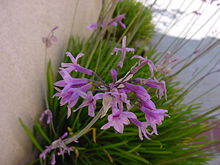Tulbaghieae
Tribe of flowering plants
You can help expand this article with text translated from the corresponding article in Spanish. (January 2015) Click [show] for important translation instructions.
- View a machine-translated version of the Spanish article.
- Machine translation, like DeepL or Google Translate, is a useful starting point for translations, but translators must revise errors as necessary and confirm that the translation is accurate, rather than simply copy-pasting machine-translated text into the English Wikipedia.
- Consider adding a topic to this template: there are already 920 articles in the main category, and specifying
|topic=will aid in categorization. - Do not translate text that appears unreliable or low-quality. If possible, verify the text with references provided in the foreign-language article.
- You must provide copyright attribution in the edit summary accompanying your translation by providing an interlanguage link to the source of your translation. A model attribution edit summary is
Content in this edit is translated from the existing Spanish Wikipedia article at [[:es:Tulbaghieae]]; see its history for attribution. - You may also add the template
{{Translated|es|Tulbaghieae}}to the talk page. - For more guidance, see Wikipedia:Translation.
| Tulbaghieae | |
|---|---|
 | |
| Tulbaghia violacea | |
| Scientific classification | |
| Kingdom: | Plantae |
| Clade: | Tracheophytes |
| Clade: | Angiosperms |
| Clade: | Monocots |
| Order: | Asparagales |
| Family: | Amaryllidaceae |
| Subfamily: | Allioideae |
| Tribe: | Tulbaghieae (Meisn.) M.F.Fay & M.W.Chase |
| Genera | |
| |
| Synonyms | |
| |
Tulbaghieae is a tribe of plants belonging to the subfamily Allioideae of the Amaryllis family (Amaryllidaceae). It comprises two genera, Tulbaghia and Prototulbaghia, native to South Africa.
Description
Corm shaped bulb or rhizome. Leaf sheaths short. Flowers possess a corona, pseudocorona or a fleshy perigonal ring.[2]
References
- ^ Canio Giuseppe Vosa (2007). "Prototulbaghia, a new genus of the Alliaceae family from the Leolo Mountains in Sekhukhuneland, South Africa" (PDF). Caryologia. 60 (3): 273–278. CiteSeerX 10.1.1.494.6523. doi:10.1080/00087114.2007.10797948. S2CID 45409345. Archived from the original (PDF) on 2013-05-06.
- ^ Sassone et al. 2014.
Bibliography

Wikimedia Commons has media related to Tulbaghieae.

Wikispecies has information related to Tulbaghieae.
- Missouri Botanical Garden
- Sassone, Agostina B.; Arroyo-Leuenberger, Silvia C.; Giussani, Liliana M. (2014). "Nueva Circunscripción de la tribu Leucocoryneae (Amaryllidaceae, Allioideae)". Darwiniana. Nueva Serie. 2 (2): 197–206. doi:10.14522/darwiniana/2014.22.584. ISSN 0011-6793. Retrieved 9 January 2015.
- v
- t
- e
 Subdivisions of the Amaryllidaceae family, with type genus
Subdivisions of the Amaryllidaceae family, with type genus| Allieae | |
|---|---|
| Tulbaghieae | |
| Gilliesieae |
 Category
Category
 | This Amaryllidaceae article is a stub. You can help Wikipedia by expanding it. |
- v
- t
- e












